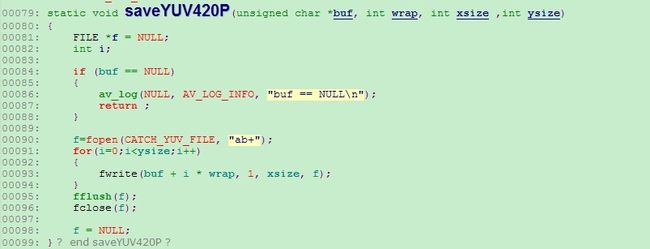FFmpeg入门(4)-An ffmpeg and SDL Tutorial 2
An ffmpeg and SDL Tutorial 2 中将1中的保存图片改为用SDL显示,在显示之前要讲本地帧改为YUV420P格式。
对照1把2 的代码进行相应修改得到:
#include <libavcodec/avcodec.h>
#include <libavformat/avformat.h>
#include <libswscale/swscale.h>
#include <SDL/SDL.h>
#include <SDL/SDL_thread.h>
#include <unistd.h>
//slq
static AVFormatContext *pFormatCtx = NULL;
int main(int argc, char *argv[]) {
// AVFormatContext *pFormatCtx;
// static AVFormatContext *pFormatCtx = NULL;
AVCodecContext *pCodecCtx;
AVCodec *pCodec;
AVFrame *pFrame;
AVFrame *pFrameRGB;
AVPacket packet;
SDL_Surface *screen;
SDL_Overlay *bmp;
uint8_t *buffer;
int numBytes;
int i;
av_register_all();
//slq
//reads the file header and stores information about the file format in the AVFormatContext structure pFormatCtx
if (avformat_open_input( &pFormatCtx, argv[1], NULL, NULL) < 0)
//if (avformat_open_input( &input_fmt_ctx, input_file, NULL, NULL) < 0) {
//if (av_open_input_file(&pFormatCtx, argv[1], NULL, 0, NULL) != 0)
return -1;
// Retrieve stream information
if (av_find_stream_info(pFormatCtx) < 0)
return -1;
// Dump information about file onto standard error
// dump_format(pFormatCtx, 0, argv[1], 0);
av_dump_format(pFormatCtx, 0, argv[1], 0);
// Find the first video stream
int videoStream = -1;
for (i = 0; i < pFormatCtx->nb_streams; ++i) {
if (pFormatCtx->streams[i]->codec->codec_type == AVMEDIA_TYPE_VIDEO) {
videoStream = i;
break;
}
}
// Get a pointer to the codec context for the video stream
pCodecCtx = pFormatCtx->streams[videoStream]->codec;
// Find the decoder for the video stream
pCodec = avcodec_find_decoder(pCodecCtx->codec_id);
if (pCodec == NULL) {
fprintf(stderr, "Unsupported codec@!\n");
}
// Open codec
//slq
if (avcodec_open2(pCodecCtx, pCodec, NULL) < 0)
//if (avcodec_open(pCodecCtx, pCodec) < 0)
return -1;
// Allocate video frame (native format)
pFrame = avcodec_alloc_frame();
// Allocate an AVFrame structure ( RGB )
pFrameRGB = avcodec_alloc_frame();
if (pFrameRGB == NULL)
return -1;
// we still need a place to put the raw data when we convert it.
//We use avpicture_get_size to get the size we need,
//and allocate the space manually:
// Determine required buffer size and allocate buffer
numBytes = avpicture_get_size(PIX_FMT_RGB24, pCodecCtx->width,
pCodecCtx->height);
//av_malloc is ffmpeg's malloc that is just a simple wrapper around malloc that makes sure the memory addresses are aligned and such.
buffer = (uint8_t *) av_malloc(numBytes * sizeof(uint8_t));
// Assign appropriate parts of buffer to image planes n. 图像平面;映像平面 in pFrameRGB
// Note that pFrameRGB is an AVFrame, but AVFrame is a superset
// of AVPicture
avpicture_fill((AVPicture *) pFrameRGB, buffer, PIX_FMT_RGB24,
pCodecCtx->width, pCodecCtx->height);
/*
* SDL
*/
//SDL_Init() essentially tells the library what features we're going to use
if (SDL_Init(SDL_INIT_VIDEO | SDL_INIT_AUDIO | SDL_INIT_TIMER)) {
fprintf(stderr, "Could not initialize SDL - %s\n", SDL_GetError());
exit(1);
}
//This sets up a screen with the given width and height.
//The next option is the bit depth of the screen - 0 is a special value that means "same as the current display".
screen = SDL_SetVideoMode(pCodecCtx->width, pCodecCtx->height, 0, 0);
if (!screen) {
fprintf(stderr, "SDL: could not set video mode - exiting\n");
exit(1);
}
//using YV12 to display the image
bmp = SDL_CreateYUVOverlay(pCodecCtx->width, pCodecCtx->height,
SDL_YV12_OVERLAY, screen);
i = 0;
while (av_read_frame(pFormatCtx, &packet) >= 0) {
// Is this a packet from the video stream?
if (packet.stream_index == videoStream) {
int frameFinished;
/*
avcodec_decode_video(pCodecCtx, pFrame, &frameFinished, packet.data, packet.size);
*/
avcodec_decode_video2(pCodecCtx, pFrame, &frameFinished, &packet);
// Did we get a video frame?
if (frameFinished) {
#ifdef SAVEFILE
/*保存到文件*/
/*
*此函数已经不用
img_convert((AVPicture *)pFrameRGB, PIX_FMT_RGB24, (AVPicture*)pFrame, pCodecCtx->pix_fmt, pCodecCtx->width, pCodecCtx->height);
*/
static struct SwsContext *img_convert_ctx;
img_convert_ctx = sws_getContext(pCodecCtx->width, pCodecCtx->height , pCodecCtx->pix_fmt,
pCodecCtx->width, pCodecCtx->height, PIX_FMT_RGB24, SWS_BICUBIC , NULL, NULL, NULL);
sws_scale(img_convert_ctx, (const uint8_t* const*)pFrame->data, pFrame->linesize,
0, pCodecCtx->height, pFrameRGB->data, pFrameRGB->linesize);
if(++i <= 5)
SaveFrame(pFrameRGB, pCodecCtx->width, pCodecCtx->height, i);
#else
/*显示 */
AVPicture pict;
static struct SwsContext *img_convert_ctx;
SDL_Rect rect;
SDL_LockYUVOverlay(bmp);
pict.data[0] = bmp->pixels[0];
pict.data[1] = bmp->pixels[2];
pict.data[2] = bmp->pixels[1];
pict.linesize[0] = bmp->pitches[0];
pict.linesize[1] = bmp->pitches[2];
pict.linesize[2] = bmp->pitches[1];
/*
// Convert the image into YUV format that SDL uses
img_convert(&pict, PIX_FMT_YUV420P, (AVPicture *) pFrame,
pCodecCtx->pix_fmt, pCodecCtx->width, pCodecCtx->height);
*/
img_convert_ctx = sws_getContext(pCodecCtx->width,
pCodecCtx->height, pCodecCtx->pix_fmt,
pCodecCtx->width, pCodecCtx->height, PIX_FMT_YUV420P,
SWS_BICUBIC, NULL, NULL, NULL);
sws_scale(img_convert_ctx,
(const uint8_t* const *) pFrame->data,
pFrame->linesize, 0, pCodecCtx->height, pict.data,
pict.linesize);
SDL_UnlockYUVOverlay(bmp);
rect.x = 0;
rect.y = 0;
rect.w = pCodecCtx->width;
rect.h = pCodecCtx->height;
SDL_DisplayYUVOverlay(bmp, &rect);
#endif
usleep(25000);
}
}
// Free the packet that was allocated by av_read_frame
av_free_packet(&packet);
}
av_free(buffer);
av_free(pFrameRGB);
av_free(pFrame);
avcodec_close(pCodecCtx);
av_close_input_file(pFormatCtx);
return 0;
}
程序2编译 运行
gcc -o tutorial02 tutorial02.1.c -lavutil -lavformat -lavcodec -lz -lm `sdl-config --cflags --libs`
gcc -g -o tutorial02 tutorial02.1.c -lavutil -lavformat -lavcodec -lswscale -lz -lm -lpthread `sdl-config --cflags --libs`

YUV420P格式分析
http://my.oschina.net/u/589963/blog/167766



